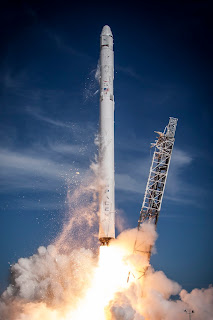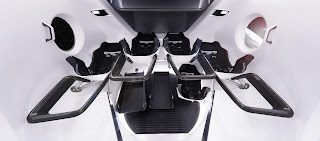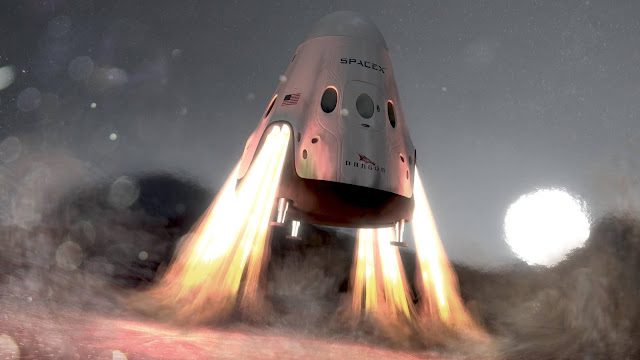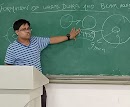Space Exploration
Space X Dragon: Engineering of the Dragon that conquered human private spaceflight industry!!!
Well, Dragons are always fascinating…be it in fiction or in modern
times….
If anyone would tell somebody back in 2002 that, there would be one
private company in 2020 which would launch humans in the space and safely
return them to earth then, there would be high chance that people would laugh
at that person.
Now fast forward to 2020, that goal is finally achieved. Elon Musk’s
Space X did it in their first-ever try.
Well, Dragon of SpaceX is operating from 2010, and since then indulged
delivering cargo to International space station. But after 2011, when space
shuttle retired America lacked the capability to launch humans to space and
relied only on Russian’s Soyuz program.
 |
| Falcon 9 carrying CRS-6 Dragon (Dragon 1 used) |
SpaceX used their Dragon 1 to supply cargo to ISS which they retired on 7th March 2020. Dragon 2 comes with two variant: one for cargo missions and another for crewed missions. Crewed version of Dragon 2 has been developed especially to achieve human spaceflight ability and thus winning the contract for the NASA’s Launch America program.
 |
| Space X Demo-2 launch (source NASA) |
On 30th May 2020, SpaceX launched humans for the first time
under their Demo-2 mission. The mission lasted 63 days, 23 hours and 25
minutes, while being docked for 63 days, 9 hours and 8 minutes. Astronauts Bob
Behnken and Doug Hurley were the astronauts involved in this mission. The craft
was later named as Endeavour.
All of the Dragons are launched by Falcon 9 rockets.
 |
| Maiden launch of Dragon-2 during Demo-1 mission (source wikimedia) |
Engineering and Design of Dragon Spacecraft
Dragon spacecraft uses the conventional space capsule which is also
known as ballistic capsule and also has a cargo carrier trunk at the back of
the craft. The cargo carrier trunk also can be extended and is always
unpressurized. It is also attached to two solar panels.
 |
| Dragon docked with ISS (the upper docked part is the capsule and the lower part which have solar panels in trunk) |
For heat resistant shield the craft uses the variant of NASA’s Phenolic impregnated carbon ablator material known as PICA-X heat shield. The Phenolic impregnated carbon ablator is a carbon-fibre material infused in phenolic resin. It has the advantage of low density and its good ablative ability making it a useful resource for making heat shield. PICA’s thermal conductivity is lower than conventional carbon phenolics.
 |
| Heat shield of Dragon capsule |
The trunk part of the spacecraft is not reusable but the capsule part
is reusable and can be used multiple times. The trunk part separated from the
capsule when the spacecraft re-enters the Earth’s atmosphere and thus burns up
in the atmosphere.
As we have seen in many other spacecraft, the SpaceX Dragon also uses
three pairs of triple-processor computers (total six computers) to check each
other’s result to reduce the chances of failure of machinery and achieve a
fault-tolerant design. If anyhow any technical malfunction happens due to
radiation or any other reason, one of the pair will initiate soft reboot. These
6 computers make the main flight computers. Other than these the dragon have
another 12 computers to support it.
Dragon uses GLACIER and MERLIN freezer modules for transporting
essential and critical scientific payloads.
The dragon spacecraft have 18 Draco thrusters to navigate itself.
Draco thruster is a hypergolic liquid rocket engine. Hypergolic engines are
those engines which use the propellants which spontaneously ignite when they
come in contact with each other. Draco thrusters can generate 400 newtons of
thrust. It uses mixture of monomethyl hydrazine fuel and tetroxide oxidizer.
 |
| Dragon using its Draco thrusters (souce wikimedia) |
For satellite communication, RS-422(commercial standard) and 1553 (Military Standard US) serial I/O is used. It also uses Ethernet communications for IP addressable standard payload service. The communication system also provides a command uplink of about 300 kbps and data downlink as 300Mbit/s. Apart from these, S-band telemetry is also used and fault-tolerance is ensured. S-band is a designation for a part of the microwave band covering frequencies from 2 to 4 gigahertz (GHz). This designation is given by Institute of Electrical and Electronics Engineers (IEEE).
Dragon’s Specification
Cargo Transport Capacity: 3310 kg
Pressure vessel payload Volume: 10 cubic meter
Unpressurized payload volume: 0.1 cubic meter
Solar arrays power production: 4 kW (peak), 1500 (average) at 120 and
28 direct current voltage
Unpressurised payload volume: 0.1 cubic meter
Unpressurised non-recoverable normal trunk: 14 cubic meter payload
volume in the 7ft 7 inches (in length) trunk
Unpressurised non-recoverable extended trunk: 34 cubic meter volume
when trunk extended to 4.3 m (in length)
It also supports sensors and space apertures up to 3.5 m in diameter
in the trunk section.
Apart from all of these, Space X also had plans to use their Dragon
spacecraft in their Mars missions. They named it as ‘Red Dragon’. Later the
project was scrapped as the company increased their focus on the BFR Starship project to fulfil their requirements for Mars Endeavour.
 |
| Astronaunts Bob Behnken and Doug Hurley inside Dragon capsule (source space connect) |
We have to see now, in the future, what this company is holding for humanity. There is certainly no doubt that this company is achieving great heights today and will achieve in the future.
 |
| Crew Dragon's interior |
In my future posts, I will continue to write about various space
exploration articles which will include the contribution of not only Space X
but also other great space agencies like ISRO, NASA, ESA, JAXA etc. If you like
my articles then please consider subscribing our newsletter and follow this blog to get the latest updates directly to you
To know basics of quantum world, astronomy and space exploration you can check out my book "Through the wormhole" on amazon kindle.
Thanks for Reading!!!
Check out my other blog posts!!!
Don't forget to share this post in your social media handles to enrich everyone's knowledge!!!
You can directly talk with me on Instagram
To meet more physics Enthusiasts please join our Facebook Page
Also for latest updates of my posts join me on Twitter
See you Again!!!!!
-Ratnadeep Das Choudhury
Founder and writer of The Dynamic Frequency












0 Comments